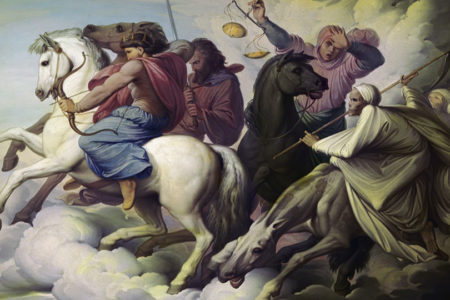Finding Eden
Long ago, in the misty echoes of ancient time, there was a first man and a first woman. They walked in the cool, green shade, surrounded by lush, fruitful trees and benevolent beasts. The region was watered by a great river that had its headwaters there and then branched into four other great rivers of the Middle East. The Bible tells us this place had a name. It was called Eden.
And so we are told, “eastward in Eden” God planted a garden (Gen. 2:8). He placed the man and woman there, telling them to live, flourish, and exercise dominion (1:28; 2:15). In the garden was a special tree: the tree of life (Gen. 2:9).
Few locations in world history evoke such powerful images as does the Garden of Eden. Poets have been inspired by its peaceful beauty, and philosophers have sought to emulate its balance by contriving their own theories of utopia.
Still others use Eden as a metaphor for political and social harmony. Israel-based journalist Yossi Klein Halevi, on his quest to find a key to peace in that region, wrote of a legend described in the Zohar, a chief source of Jewish mysticism. The tale has Abraham encountering Adam and Eve’s grave. There he sees an opening to the Garden of Eden. His eyes become transfixed, and his heart yearns to dwell there forever.
For those of us who believe the Bible, Eden, like other important sites in Scripture, becomes a place where geography and theology converge in an incredible drama where God is both the Divine Playwright and Leading Character. In a rather amazing way, the Garden of Eden becomes the scenery for both the beginning and the promised ending of the greatest story ever told.
A Creation of Paradise
The Genesis account makes it clear that the Garden of Eden was both physically beautiful and environmentally perfect. It is also plain that the Bible speaks of it as an actual, existing site, though it gives only enticing hints as to its exact location.
Merrill Unger’s Commentary on the Old Testament offers the traditional view that the Sumerian roots of the word Eden indicate the Garden stood somewhere in the oldest cultural strata of mesopotamia, possibly at the head of the Persian Gulf. Archaeologist Juris Zarins shared this view in an interview with Smithsonian Magazine.
There is some geographical support for this view. The headwaters of the Tigris and Euphrates rivers are described as flowing out of Eden (Gen. 2:10–14). These two rivers, together with the “Pishon” and “Gihon” rivers, all found a common source in Eden (vv. 11, 13). The Tigris and Euphrates both exist today and flow into the Persian Gulf, supporting this traditional theory. The problem is that neither the Pishon nor the Gihon are current geographical entities. Juris Zarins speculates that, based on satellite photos, the Pishon could be Wadi Batin, a fossilized riverbed running through Saudi Arabia; and the Gihon might be the Karun River, which rises in Iran and flows toward the Gulf.
On the other hand, there is intriguing evidence of an Eden-Jerusalem connection. To conclude that the Garden of Eden may have been located in the current site of Jerusalem, however, we first must explain away the four-rivers issue, as neither the Tigris nor the Euphrates currently run into Israel. One theory is that the catastrophic Noahic flood obliterated or, in some cases, reoriented river paths and geological features. As we see the devastating result of one tsunami that hit recently on a single day in the Indian Ocean, we can imagine the force of a global flood lasting 40 days.
There are biblical and linguistic clues that link Jerusalem with the Garden of Eden. Harvard Archaeologist Lawrence E. Stager notes that, during the united monarchy in Israel, there were strong suggestions of such a link. In an article in Biblical Archaeology Review (BAR), he points out that, during the building of Solomon’s Temple on the Temple Mount in Jerusalem, the iconography and architectural details hearken back to several features of the first paradise.
After the Fall of Man, God posted angelic cherubim to guard the Garden’s eastern entrance, to block access to the “tree of life” (Gen. 3:24). Compare this with Solomon’s Temple, where elaborate images of cherubim filled the inner sanctuary (1 Ki. 6:23–28). There are strong suggestions that, like the Garden of Eden, the Temple (the House of God) flourished with trees and greenery (Ps. 52:8; 92:12–14).
Ezekiel 31:8–9 speaks of the trees in “the garden of God,” and then links that in verse 16 with “the trees of Eden, the choice and best of Lebanon.” Clearly, the reference is not to an “Eden” that was in Saudi Arabia or the Persian Gulf.
In his article in the November/December 2004 issue of Israel My Glory, Jimmy DeYoung cited the fact that in Ezekiel 28:14, 16, the phrase mountain of God, referring to the Temple mount, is equated with the Garden of Eden. Ezekiel 28:13 describes the same place as being “in Eden, the garden of God.”
Finally, in a recent letter to the editors of BAR, Rabbi Bernard Bloom said the mysterious Gihon River of Genesis may not be missing after all; in fact, it is linked with Jerusalem. Gihon was the name of the main spring and water source for David’s Jerusalem. Furthermore, King David ordered his servants to take his son Solomon down to the Gihon stream to anoint him as king (1 Ki. 1:32–40).
A Courtroom of Judgment
However, to quote the English poet John Milton, the perfection of Eden eventually became “paradise lost.” Adam’s utter failure of moral leadership and his embarrassing attempt to shift the blame (Gen. 3:12), plus Eve’s willingness to be deceived and the couple’s direct disobedience to God’s eternal command in deference to temporal enticement (Gen. 3:2–13), are shockingly reminiscent of all our universal struggles with sin, as we fight against “the lust of the flesh, the lust of the eyes, and the pride of life” (1 Jn. 2:16).
What had been an ideal relationship of communion between God and man, woman, and nature was now smashed and disfigured. Though He is Creator, Nurturer, and divine Father, God is also a holy and righteous Judge. His clear, perfect moral law would have been empty and meaningless had it not been inexorably connected to consequences—and punishment. Because of sin, God converted the lush paradise of peace and tranquility into a courtroom for the execution of judgment.
For the 30 years I have been trying cases in court, I can recall one common sensation in every case. In those final minutes before the judge gavels the case back into session to announce a decision, or in that instant before the jury foreman passes the verdict to the court to read it aloud, there is one final, trembling, fearful moment. It is the recognition that justice—albeit a frail, imperfect, and abundantly human type—is about to be administered.
Now think about divine justice meted out by the High King of the universe. If the prophets and righteous men of old fell on their faces at the appearance of angels who had come from the mere presence of God, what must it be like to fall into the hands of that righteous God himself who must execute judgment?
Here, also, is a clear connection to Jerusalem. In Eden, God passed judg-ment on the “first Adam” because of sin. Later, at the end of Jesus’ earthly ministry, God exercised judgment in Jerusalem by permitting His own Son, the “second Adam,” to be wrongly arrested, charged, and convicted because of the sin of us all (1 Cor. 15:22, 45).
A Consolation of Grace
Happily for us, the story doesn’t end with condemnation and punishment. God graciously covered the couple’s shame with animal skins (Gen. 3:21), prefiguring the necessity of blood sacrifice for the covering of sin.
The Lord also promised victory over the power of Satan—the demonic, beguiling serpent. To the serpent, God said, “He [the Redeemer] shall bruise your head, and you shall bruise His heel” (3:15), clearly referring to Jesus, the promised Messiah and perfect Lamb of sacrifice. And though Adam and Eve were evicted from Eden and the entrance barred, we know that the great Hero of this story will yet appear. The first appearance of the King of kings was to fulfill Genesis 3:15—to overcome the power of Satan, the sting of death, and the seeming invincibility of sin.
And as our Savior hung in indescribable physical and spiritual agony on the cross, He took the time to look with kindness on the believing thief next to Him. Jesus told him, “Assuredly, I say to you, today you will be with me in Paradise” (Lk. 23:43).
In the Greek, the word paradise can also be rendered “garden” or “park.”1 How incredible that our Lord used a phrase reminiscent of the Garden of Eden before the fall in His promise to the dying, repentant criminal who was suffering on the cross next to Him.
But that is not the end of the story of Eden. There is a second appearing of the Messiah and a future role for the Garden of God.
Back to the Future
The Bible is clear: There will be a future end of days and an eternal Kingdom where God will reign, His Son will be glorified, and where we who have believed on the name and in Jesus’ blood sacrifice will abide.
God will create a heavenly Jerusalem. Some of its features will be powerfully familiar: a great river that flows from the throne of God, much like the first Eden. It will water a special tree, the Garden of Eden’s “tree of life,” which now reappears and will yield its fruit and heal the nations with its leaves (Rev. 22:1–2). Permanent peace in Jerusalem, which will have evaded us all throughout all of the millennia, shall finally be achieved.
And when we are there, basking in the glory and love of Him who wooed us to salvation and walking the paths of His future garden city, I can just imagine looking past the smiling faces of the millions of His children and seeing the faces of one man and one woman who are standing quietly off to the side, by that great tree. And in their visage I vaguely recognize the features of everyone I have ever known. And the man and woman are smiling as if to say, “So you see, the Lord has brought us, all of His children, all the way back home to be with Him in His wonderful Garden after all, hasn’t He?Just like He said He would.”
ENDNOTE
- Colin Brown, ed., The New International Dictionary of New Testament Theology (Grand Rapids: Zondervan, 1976), 760-764.







I want to learn more.
This is an issue that I have done much study and research on and it produced a discourse of my own. Based on information contained in the Scriptures, both Old and New Testaments, the location of the garden of Eden was indeed Jerusalem with Mt. Moriah being the location proper.